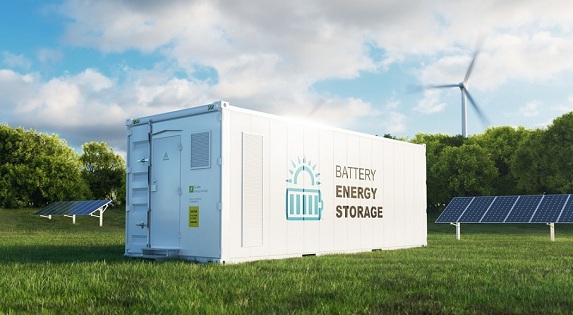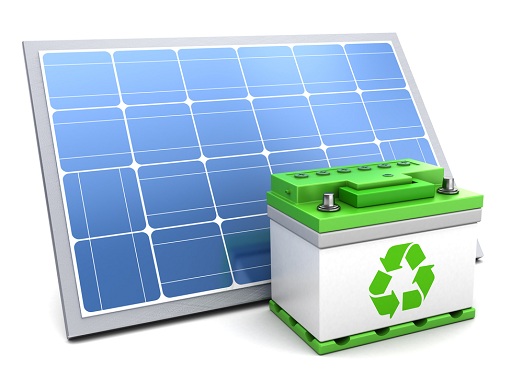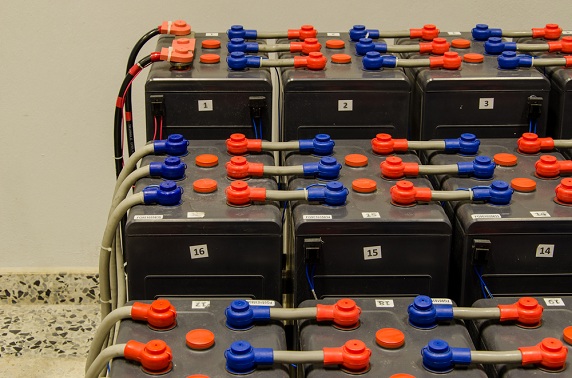The two most common questions people ask us when it comes to solar generators and solar batteries are:
How long will the battery last?
How long will it take to recharge the battery?
It’s important to know the answers to these questions when you are choosing a solar generator or battery for your solar system.
You need to know whether the battery capacity is adequate for your needs and whether you can recharge it in a reasonable amount of time (a few hours).
In this post, we guide you through calculations for figuring out battery run time and recharge time, so you can make an informed decision.
Understanding Battery Capacity: Watt-hours & Amp-hours

Before we get into the calculations, let’s talk about the capacity of a solar battery, whether it’s a battery bank connected to solar panels or a battery built into a solar generator.
Knowing the capacity of a battery will let you calculate how long it can power appliances and how long it’ll take to recharge it.
Battery capacity is usually given in either watt-hours (Wh) or amp-hours (Ah).
Watt-hours is the amount of power a battery can deliver for an hour. On paper, a 1,000Wh battery can deliver 1,000 watts of power for an hour.
In reality, the amount of power it can deliver depends on its chemistry. If it’s a lead-acid battery, which has a 50% depth of discharge, it’ll deliver only 500 watts.
If it’s a lithium battery (80-90% DoD), it can deliver 800-900 watts.
As for amp-hours, it’s the amount of current the battery can deliver in an hour. Amp-hours is good for comparing the capacity among batteries, but it’s not ideal for calculating run time and recharge time.
For that, watt-hours is the best unit.
If you have a battery whose capacity is only listed in Ah, multiply that number by the battery’s voltage to get its capacity in Wh.
If you have a 100Ah 12V battery, its approximate capacity in Wh is 1,200Wh (100X12).
Make sure you know the capacity of your battery or solar generator in Wh before we start crunching the numbers.
Factors Affecting Battery Life
How long battery charge lasts depends on several factors.
How To Calculate Battery/Solar Generator Run Time

For the sake of keeping our calculations simple, we’ll only consider two of the above factors when calculating how long a solar generator will last: power consumption and battery chemistry.
As long as the solar generator or battery bank is in good condition and is not exposed to extreme temperatures, using the following calculations will give you a pretty accurate idea of what to expect.
To determine how long your battery will last, you need to know battery capacity, how much power you are using, and how much you can discharge the battery.
Let’s say we have a small 500Wh camping solar generator like the Jackery Explorer 500.
We have a camping mini fridge that uses roughly 50Wh of power.
To calculate how long the solar generator will last when the mini fridge is plugged in, we divide the battery capacity with the power consumption of the appliance - 500Wh/50Wh = 10 hours
We could power our fridge for 10 hours straight.
Our solar generator has a lithium battery that discharges to 80%. So in reality, we don't have a 500Wh capacity. The usable capacity is actually 400Wh (80% of 500Wh).
Recalculating the solar generator run time (400Wh/50Wh), we get 8 hours.
Note: If we connect the mini fridge via the AC outlet, the runtime could be slightly lower than this because the inverter is not 100% efficient. That’s why getting 12V appliances for camping and outdoors gets you a longer battery life since you can bypass the inverter.
You can repeat the above calculation for any appliance.
First figure out usable battery capacity. Use 50% for lead acid and 80% for any type of lithium battery. Note that you can discharge a battery until it’s completely empty (unless there’s a battery management system that prevents that), but it’s not good for battery lifespan.
Once you have the usable capacity, divide it by the wattage of the appliance you’ve connected to it.
E.g. A 60W laptop uses 60W per hour is 60Wh. If we plug it into our 500Wh solar generator, we’ll get about 6.6 hours of use (400Wh/60Wh).
Here’s a formula you can use.
Battery run time = Usable battery capacity / Load power consumption
Tip: If you cannot find the wattage of an appliance, check whether the amperage and voltage are given. Multiply the two to get wattage.
Here’s a worksheet showing how long various electronics would last when connected to the Jackery Explorer 1000.
The Explorer 1000 has a capacity of 1,002Wh. Jackery uses a DoD of 85% in the calculations, so we’ll also use that. That means usable capacity is about 852Wh.
Load | Jackery 1000 Run Time |
TV (80W) | 10.6hrs |
Fridge (83Wh) | 10.2 hrs |
Computer (50W) | 17hrs |
5 x 15W lights | 11.3hrs |
5,000 mAh smartphone (19Wh) | 44 recharges |
Power tool (1000W) | 51 minutes |
Calculating Battery Run Time With Multiple Loads

In reality, most people don't connect just one appliance to a solar generator. You’ll have devices recharging and you may power other electronics like lights and a fan.
A solar battery bank in your home obviously powers multiple loads.
When calculating run time, you have to calculate the combined power consumption of these loads.
Say you have a 1,500Wh lithium ion solar generator for home backup. You plan to power your TV, a few lights, and your kitchen refrigerator if there’s a blackout.
Let’s calculate the total power consumption using the worksheet below.
Load | Power Consumption (Wh) |
55” TV (80W) | 80Wh |
Refrigerator (250W) | 83Wh* |
Three 10W LED lights | 30Wh |
Total | 193Wh |
*Though our fridge is rated at 250W, it doesn't consume 250Wh. That’s because it turns on and off throughout the day. It uses 2000Wh over 24 hours or 83Wh per hour on average.
If you were to connect all these three loads at the same time, you’d be drawing 193Wh of power from the 1500Wh solar generator.
Our usable battery capacity is 80% of 1500Wh which is 1200Wh. Battery run time will be 1200Wh/193Wh = 6.2 hours.
We’ll get a run time of 6.2 hours.
That said, calculating run time with multiple loads is not very helpful. That’s because you typically don't connect electronics all at the same time and some appliances run longer than others.
For instance in our example above, we might watch TV for just 3 hours, turn on lights for 5 hours, and keep the refrigerator on throughout.
When sizing a solar generator or battery bank for powering multiple electronics, it is better to calculate your total power needs and make sure the battery can supply enough power for at least a day.
Here’s a better way to size our solar generator above using the same loads.
Load | Power Consumption (Wh) | Daily power consumption |
55” TV (80W) | 80Wh | 80*3hrs = 240Wh |
Refrigerator (250W) | 83Wh* | 83*24hrs = ∼2,000Wh |
Three 10W LED lights | 30Wh | 30*5hrs = 150Wh |
Total | 193Wh | 2390Wh |
In a day, we need at least 2390Wh of power. So our 1500Wh solar generator is not enough. A 3kWh unit like the Goal Zero 3000X is more ideal for our needs. It’ll even allow us to charge a few devices.
Calculating run time is more helpful if you’ll be powering one or more electronics at the same time continuously.
Next, we calculate how long it takes to recharge a battery.
Factors Affecting Battery Recharge Time
Whether you are charging a solar generator from a wall outlet or solar panels, here are the factors that affect how long it’ll take to recharge.
How to Calculate Solar Recharge Time

To calculate how long your solar panels will take to charge a solar generator or battery bank, you need to know battery capacity and solar power output.
Then use this formula to calculate recharge time.
Battery recharge time = battery capacity or size in watt-hours / power input in watts
Say we have a 500Wh lithium solar generator and a 100W solar panel.
If you discharge the solar generator to 80% as recommended, you’ll need to put back in 400Wh to bring the battery back to full charge.
The solar panel is rated to produce 100W of power. In reality though, solar panels don't usually produce the indicated power. On most sunny days, you’ll get about 70% to 80% of the rated output.
So our 100W solar panel will likely produce 70W.
Using our formula, we can calculate recharge time by dividing 400Wh (battery capacity) by 70W (solar output). We get an approximate recharge time of 5.7 hours.
If we want to charge our solar generator in less time, we can get an additional 100W solar panel. With 200W of total output now, recharge time reduces to 2.8 hours (400Wh/140W).
Remember the real life output of the two solar panels will probably be 140W to 160W (70-80%). Output can reach 200W or even slightly more when it’s really sunny, but the average output is 140-160Wh.
Let’s try another example.
Say you have a lead acid battery bank with a total capacity of 10kWh. Going with the standard 50% depth of discharge of lead acid batteries, you’ll need to add 5kWh to the batteries to get them to 100%.
If you set up a solar array that outputs 2000W (2kW), actual average output will be 1400-1600W. Let’s go with 1400W.
Recharge time will be 5000Wh/1400W = 3.5 hours.
Calculating battery recharge time is important when you are buying solar panels. It’s a good idea to set up a solar array that can recharge your solar generator or battery bank in less than a day.
That ensures that by evening, you have a full battery that you can use at night.
Note: Use the same formula above if you are recharging a solar generator from a wall outlet. Divide the battery capacity by the amount of power the AC adapter produces.
Frequently Asked Questions
How do I charge my solar generator faster?
To charge a solar generator or power station faster, you need to put in more power. You can do this by getting a higher powered AC adapter from the manufacturer.
For instance, Goal Zero sells a 600W AC adapter for their 3000X power station, which halves charging time.
If you are charging with solar, the only way to increase power is adding more solar panels.
How long will a 100Ah battery run an appliance that requires 400W?
The first step is converting Ah to Wh. Assuming this is a 12V battery, we simply multiply 100Ah x 12V to get 1200Wh.
Then we get the usable capacity of the battery. If it’s a lithium battery, it’ll be 80% (960Wh) and if it’s a lead-acid battery, it’ll be 50% (600Wh).
To calculate run time with a 400W appliance connected, you divide usable battery capacity by the appliance’s wattage.
It’s 2.4 hours with the lithium battery (960/400) and 1.5 hours with the lead acid battery (600/400).
How long will a 300W solar panel take to charge a 100Ah battery?
A 100Ah 12V battery has a capacity of 1,200Wh.
The 300W solar panel will produce an average of 70-80% of its rated output, so 210-240W. Let’s use an average solar output of 210W.
To calculate recharge time, we divide battery capacity by solar output. 1200/210 gives us 5.7 hours recharge time.
However, if you’d only discharged the battery to the recommended depth of discharge, recharge time will be shorter.
For a lead acid battery (50% DoD) it will be 600Wh/210 = 2.8 hours. For a lithium battery (80% DoD) it will be 960Wh/210 = 4.5 hours.
How do I calculate the battery size I need?
Figure out how much power you consume in a day. Find the wattage of each appliance and multiply it by the number of hours you run it each day to get watt-hours.
Then add the watt-hours for all appliances to get your total power consumption. Add a margin for smaller stuff like lights and recharging your smartphone. Also add a 20% margin to account for depth of discharge for a lithium battery.
Then get a solar generator with capacity slightly higher than the figure you’ve calculated above.
For a solar system battery bank, calculate how much you need in a day. Add up the watt-hours for all electronics or calculate your average daily consumption using power bills for the last 12 months.
Add a 20% margin for depth of discharge (add a 50% margin for a lead acid battery bank). Then, multiply the total power you need by 3 days to account for bad weather.
The figure you get is the total battery capacity you need.
How can I make my solar battery charge last longer?
Keep the batteries or solar generator at close to room temperature to make sure the battery retains its maximum capacity.
When using a solar generator for camping and outdoors, use 12V appliances as much as you can. Plugging appliances into the 12V port results in fewer energy losses compared to using the AC outlet.
Also remember to turn off the inverter when you are not using it. If it’s turned on, it’s using power even if there’s nothing plugged in.
Don't leave appliances plugged in on standby. They’ll still draw some power and the inverter is also using power. Unplug them and turn off the inverter.


